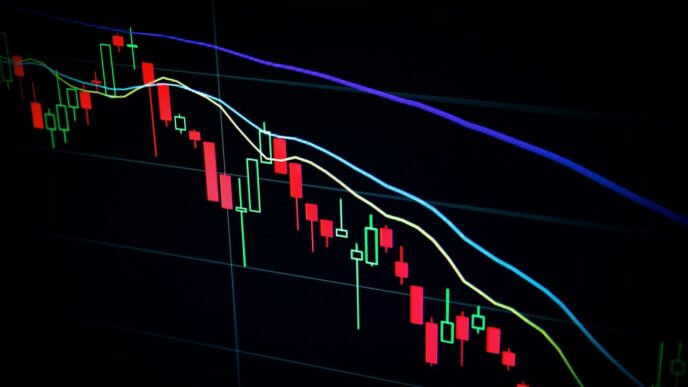It’s 2025, and the world of money moves fast. To make smart choices with your investments, you need good information. But with so many places to get news, how do you pick the best financial news source? This guide will walk you through what to look for, from figuring out what kind of news you need to checking if a source is trustworthy. We’ll help you find the right fit so you can stay on top of your money game.
Key Takeaways
- Figure out what kind of investor you are and what data you really need before picking a news source.
- Big names like Bloomberg are good for lots of info, but smaller, focused sites can be better for specific topics.
- Always check if the news you’re reading is accurate and if the people writing it are fair.
- A good news site should be easy to use on your phone and let you change settings to see what you want.
- Think about if paying for news is worth it for you, and how to get the most from any subscription.
Understanding Your Financial News Needs
Before you jump into the world of financial news, it’s smart to figure out what you actually need. Are you a day trader glued to every tick, or a long-term investor who checks in once a quarter? What kind of data is important to you? And how much are you willing to spend to get it? Let’s break it down.
Identifying Your Investment Style
Your investment style is the foundation for choosing the right news sources. Knowing if you’re a day trader, swing trader, or long-term investor dramatically changes the type and frequency of information you need. A day trader needs real-time data and breaking news alerts, while a long-term investor might focus on in-depth analysis and quarterly reports. It’s like comparing a race car driver to someone on a cross-country road trip – different vehicles, different needs.
Determining Essential Data Requirements
What data do you really need? Are you obsessed with earnings reports, or do you live and die by technical indicators? Maybe you’re all about M&A news and corporate actions. Pinpointing your data needs helps you filter out the noise and focus on what matters. For example:
- Stock prices: Real-time or end-of-day?
- Financial statements: Balance sheets, income statements, cash flow statements?
- Analyst ratings: Buy, sell, or hold recommendations?
- Economic indicators: GDP, inflation, unemployment?
Assessing Your Budget for Financial Information
Financial news comes at a cost. Some sources are free, some have premium subscriptions, and others are downright expensive. Think about how much you’re willing to spend. There are plenty of free resources like Yahoo Finance that offer a good starting point. But if you need in-depth analysis or specialized data, you might have to open your wallet. Consider these options:
- Free: Basic news, limited data, often ad-supported.
- Subscription: More in-depth analysis, fewer ads, potentially real-time data.
- Premium: Exclusive content, advanced tools, personalized support.
Top Tier Financial News Platforms
Bloomberg: The Industry Standard
Bloomberg is often seen as the gold standard. It’s a powerhouse for real-time financial data and news. Think of it as the tool the pros use. It’s got pretty much everything you could want, from breaking news to in-depth analysis. The downside? It comes with a hefty price tag. If you need the absolute best and can afford it, Bloomberg is tough to beat. For staying on top of M&A deals, Bloomberg is a great resource.
Morningstar: In-Depth Fund Analysis
If you’re really into funds – mutual funds, ETFs, that sort of thing – Morningstar is a great choice. They’re known for their independent research and ratings. They give funds star ratings, analyst reports, and all sorts of data to help you make informed decisions. It’s not just about stocks; Morningstar gives you a broader view of the investment landscape. Here’s a quick look at what they provide:
- Fund ratings and analysis
- Portfolio tools
- Independent research reports
Seeking Alpha: Diverse Investment Perspectives
Seeking Alpha is a bit different. It’s a platform where a bunch of different contributors share their investment ideas and analysis. You get a wide range of perspectives, which can be really helpful. But, you also need to be careful. Not everyone on there is a seasoned pro, so you need to do your own research and think critically about what you read. It’s a good way to get different viewpoints, but don’t take everything as gospel. It’s a good alternative to a Bloomberg Terminal if you are looking for something more user-friendly.
Specialized Financial News Sources
Sometimes you need to go deeper than the general financial news. That’s where specialized sources come in. They focus on specific areas of finance, giving you a more detailed view. It’s like switching from a wide-angle lens to a zoom lens – you see less of the overall picture, but you see the details much clearer.
M&A News: Staying Ahead in Corporate Deals
Mergers and Acquisitions (M&A) news is crucial if you’re involved in corporate finance, investment banking, or private equity. Staying informed about the latest deals can give you a competitive edge. It’s not just about knowing what deals are happening, but also why and how they’re structured. Here are some things to consider:
- Bloomberg M&A: A go-to source for real-time updates and in-depth analysis of global M&A activity. It’s designed for finance professionals needing the latest on market-moving deals.
- Financial Times (FT) M&A: Offers high-level analysis and comprehensive reporting on global deal activity. It’s a top source for senior executives and dealmakers.
- The Middle Market: Focuses on M&A activity in the middle market, providing news and analysis often overlooked by larger outlets. It’s ideal for those targeting mid-sized transactions.
Technical Analysis: Charting Market Movements
Technical analysis is all about using charts and indicators to predict future price movements. If you’re a trader or investor who relies on technicals, you need a source that provides quality charting tools and analysis. It’s about understanding patterns and trends, and having access to the right data to make informed decisions. You can find resources that offer:
- Real-time charting tools.
- Expert analysis of chart patterns.
- Screeners to find stocks meeting specific technical criteria.
Global Market Insights: Beyond Domestic Borders
In today’s interconnected world, it’s important to look beyond domestic markets. Global market insights can help you understand international trends, identify opportunities, and manage risk. Having a global perspective is no longer a luxury, it’s a necessity. Here’s why:
- Diversification: Investing in global markets can help diversify your portfolio and reduce risk.
- Growth Opportunities: Emerging markets often offer higher growth potential than developed markets.
- Risk Management: Understanding global economic and political trends can help you manage risk more effectively.
For example, a resource like top finance websites can provide a broad view of global markets and financial trends.
Evaluating News Source Credibility
It’s easy to get caught up in the excitement of fast-moving markets, but before you make any decisions based on something you read, take a step back. Making sure your financial news is trustworthy is super important. You don’t want to base your investments on bad information, right?
Verifying Data Accuracy and Sourcing
Where does the news come from? That’s the first question you should ask. A reputable source will always tell you where they get their data. If they don’t, that’s a red flag. Look for sources that cite primary data providers, like official government reports or established financial data firms. Think of it like this: you wouldn’t trust a recipe from someone who won’t tell you where they got it, would you? Similarly, you need to know the origin of your financial data. For example, Bloomberg M&A is a comprehensive source for real-time news and financial data.
Here’s a quick checklist:
- Does the source clearly state where its data comes from?
- Are those sources reputable?
- Is the data up-to-date?
Assessing Editorial Independence
Think about who owns the news source. Are they connected to a particular company or industry? If so, their reporting might be biased. Editorial independence means the news outlet can report fairly, without pressure from owners or advertisers. It’s like having a referee in a game who isn’t playing for either team. You want someone who’s neutral. Look for news sources that have a clear code of ethics and disclose any potential conflicts of interest.
Reviewing User Feedback and Reputation
What are other people saying about the news source? Check online reviews and forums to see what users think. Are they generally happy with the accuracy and objectivity of the reporting? Are there complaints about bias or misinformation? A few negative reviews aren’t necessarily a deal-breaker, but if you see a pattern of complaints, that’s a warning sign. It’s like checking reviews before you buy something online – you want to see what other people’s experiences have been. Consider the best M&A news sources that offer a broad view of global deals, trends, and industry analysis.
User Experience and Accessibility
Navigating User Interface Design
Let’s be real, nobody wants a financial news platform that looks like it was designed in the 90s. A clean, intuitive interface is key. Think about it: you’re probably stressed enough about your investments already. The last thing you need is to struggle to find the information you’re looking for. Good design means easy navigation, clear data visualization, and a layout that doesn’t make your eyes cross. The best platforms prioritize user-friendliness above all else. I’ve seen some sites that are so cluttered with ads and unnecessary features that it’s almost impossible to find the actual news. A well-designed platform should feel like a breeze to use, even if you’re not a tech expert.
Mobile Accessibility for On-The-Go Updates
In 2025, if a financial news source doesn’t have a solid mobile app or a mobile-friendly website, it’s basically a dinosaur. We’re all glued to our phones, and that includes when we’re checking on our investments. The mobile experience needs to be just as good as the desktop version, if not better. This means fast loading times, a responsive design that adapts to different screen sizes, and push notifications that keep you in the loop without being annoying. I personally rely on mobile financial news apps to stay updated during my commute. It’s a game changer. Plus, consider these points:
- Real-time alerts: Immediate notifications about market-moving events.
- Offline access: Ability to read saved articles without an internet connection.
- Seamless syncing: Data and preferences synchronized across devices.
Customization Options for Personalized Feeds
Everyone has different interests and investment strategies. A one-size-fits-all approach to financial news just doesn’t cut it anymore. The ability to customize your news feed is a must-have. This includes setting up alerts for specific stocks, industries, or economic indicators. It also means being able to filter out the noise and focus on the information that matters most to you. I like to set up different feeds for my long-term investments and my more speculative plays. It helps me stay organized and avoid getting overwhelmed. Here’s a quick look at customization features:
- Keyword filtering: Block out unwanted topics.
- Source selection: Choose preferred news outlets.
- Personalized dashboards: Create custom views of key data.
Cost-Benefit Analysis of Financial News Subscriptions
It’s easy to get caught up in the hype surrounding financial news, but before you subscribe to every platform out there, let’s talk about whether it’s actually worth the money. Not all information is created equal, and what works for one investor might be a waste of cash for another. Think of it as an investment in itself – you need to see a return.
Free Versus Premium Offerings
So, what’s the real difference between free and premium financial news? Free services like Yahoo Finance are great for getting basic data and headlines. You can get a quick pulse on the market without spending a dime. However, they often lack the in-depth analysis and exclusive data that premium services provide. Premium subscriptions usually unlock detailed reports, analyst ratings, and advanced charting tools. It really comes down to how serious you are about your investments and how much time you’re willing to spend sifting through information. For example, Seeking Alpha provides completed investment research reports produced by thousands of its contributors.
Understanding Subscription Tiers and Features
Most premium financial news platforms offer different subscription tiers, each with its own set of features and price points. It’s important to carefully compare these tiers to see what you’re actually getting for your money. Some platforms might offer a basic tier with limited access to data and analysis, while others offer more comprehensive packages with advanced tools and personalized support. Consider what features are most important to you. Do you need real-time data, or are end-of-day reports sufficient? Are you looking for specific types of analysis, such as technical analysis or fundamental analysis? Understanding your needs will help you choose the right tier and avoid paying for features you won’t use. Some platforms like Morningstar Investor offer premium services that give you access to more in-depth research, investment ratings, and a suite of portfolio management tools.
Maximizing Value from Your Investment
Okay, you’ve decided to subscribe to a premium financial news service. Now what? The key is to actually use it! Don’t just let your subscription sit there collecting dust. Here are a few tips for maximizing value:
- Set aside dedicated time each week to review the news and analysis. Treat it like a part-time job. Even 30 minutes a day can make a difference.
- Take advantage of all the features the platform offers. Explore the charting tools, read the analyst reports, and participate in the community forums.
- Track your investment performance. See if the information you’re getting from the platform is actually helping you make better investment decisions.
- Don’t be afraid to cancel your subscription if it’s not working for you. There’s no point in paying for something you’re not using. Consider alternative to a Bloomberg Terminal if you are not getting the value you expected.
Ultimately, the cost-benefit analysis of financial news subscriptions is a personal one. There’s no right or wrong answer. It depends on your individual needs, investment style, and budget. But by carefully considering the factors outlined above, you can make an informed decision and get the most out of your investment.
Leveraging Aggregated News and Analysis

The Role of Financial News Aggregators
Financial news aggregators have become super important. They pull together articles, data, and reports from many sources into one place. This saves you time and helps you see the big picture without jumping between a million different websites. Think of it as your personalized financial news dashboard. It’s pretty useful for keeping up with the market.
Integrating News with Research Tools
It’s not enough to just read the news; you need to use it. A lot of platforms let you connect news feeds with your research tools. This means you can see relevant news right next to your portfolio data or stock charts. For example, if you’re looking at top tech stocks, you can instantly see any news headlines about those companies. Here’s how you might integrate news:
- Set up alerts for specific companies or sectors.
- Use news sentiment analysis to gauge market mood.
- Link news events to your trading strategies.
Utilizing Analyst Ratings and Reports
Don’t just read the headlines; dig into what the experts are saying. Analyst ratings and reports can give you a deeper understanding of a company’s potential. These reports often include:
- Revenue forecasts
- Earnings estimates
- Buy/sell recommendations
Keep in mind that analyst opinions can differ, so it’s a good idea to look at a range of sources before making any decisions. Also, consider the source of the analysis. Is it an independent firm, or is it tied to a brokerage? This can affect the objectivity of the report.
Wrapping It Up
So, there you have it. Finding the right financial news source in 2025 really comes down to what you need. Some folks want quick headlines, others want deep dives into company reports. There’s no single "best" option for everyone, and that’s okay. Think about your own investing style, how much time you have, and what kind of information helps you make smart choices. Try out a few different sources, see what clicks, and don’t be afraid to switch if something isn’t working. The goal is to stay informed without getting overwhelmed, so pick what helps you feel good about your money decisions.
Frequently Asked Questions
How do I choose the right financial news source for me?
To pick the best financial news source, first think about what kind of investor you are. Do you like to trade often, or do you prefer to invest for the long haul? This will help you narrow down your choices. Also, consider what kind of information you need most, like detailed company reports or quick market updates. And don’t forget to think about how much you’re willing to pay, as some top-notch services can be pricey.
Are there good free financial news sources available?
Yes, many great financial news sources offer free content. Websites like Yahoo Finance provide a lot of basic information, news articles, and company data without a fee. However, if you’re looking for super detailed analysis, special tools, or real-time professional data, you might need to pay for a premium subscription.
How can I tell if a financial news source is trustworthy?
A good financial news source should always tell you where its information comes from. Look for sources that get their data from trusted places like big financial data companies. Also, check if the news stories seem fair and balanced, without too much personal opinion. Reading reviews from other users can also give you a good idea of a source’s reputation.
Can I access financial news on my phone or tablet?
Absolutely! Many financial news platforms have apps or mobile-friendly websites. This means you can get important updates, check stock prices, and read news articles right from your phone or tablet, no matter where you are. This is really helpful for staying on top of fast-moving markets.
What are the benefits of paying for a financial news subscription?
Premium subscriptions often give you access to deeper analysis, exclusive reports, special tools like stock screeners, and real-time data that free versions don’t offer. They can also provide a cleaner, ad-free experience. If you’re a serious investor, these extra features can be worth the cost because they help you make better decisions.
What is a financial news aggregator and why should I use one?
Financial news aggregators are like central hubs that collect news articles from many different sources. They save you time by putting all the important headlines in one place, so you don’t have to visit many different websites. This helps you get a broad view of the market quickly and easily.














